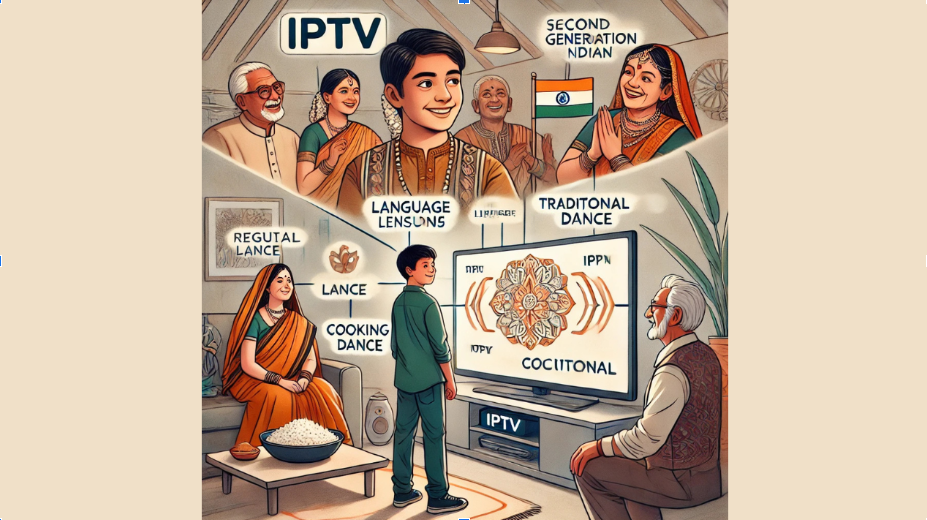
How IPTV Helps Second-Generation Indians Connect with Their Roots?
For many Indian families living abroad, raising children in a culturally rich yet foreign environment comes with its challenges. The second generation—those born and brought up outside of India—often grow up speaking English, attending Western schools, and being immersed in a different societal framework. While this opens many doors, it also presents a growing concern: How do you help second-generation Indians stay connected with their heritage, language, and traditions?
The answer for many modern families lies in IPTV—Internet Protocol Television. Platforms like Indian IPTV are playing a surprisingly impactful role in bridging the cultural gap for second-generation Indians. From language exposure and religious programming to regional storytelling and cultural festivals, IPTV is proving to be more than just entertainment—it’s an anchor to one’s identity.
Understanding the Identity Gap
Second-generation Indians often face what’s known as a cultural disconnect—a situation where they feel Indian at home but disconnected from India in everyday life. They may speak only limited phrases of their native language, know little about regional customs, or only celebrate major Indian holidays in a surface-level way.
Parents naturally try to bridge this gap through stories, festivals, and family visits to India. However, frequent travel isn’t always feasible, and day-to-day exposure to Indian culture becomes difficult in a Westernized environment.
This is where IPTV fills a critical role—by offering a daily, passive, and immersive connection to Indian language, culture, and values right from the living room.
See also: How Tech Is Making Live Casino Games More Immersive Than Ever
Language Exposure Through IPTV
Language is the heart of cultural identity. For second-generation Indians, retaining or learning a native language like Malayalam, Telugu, or Punjabi can be difficult when English is the primary medium of communication outside the home.
Services like Malayalam IPTV provide an easy and entertaining way for children to hear and pick up their ancestral language:
- Watching Malayalam cartoons, serials, and news helps children associate the language with everyday use.
- Regional kids’ shows help build vocabulary through songs, repetition, and storytelling.
- Exposure to different accents, dialects, and cultural references enhances linguistic comprehension naturally.
Unlike formal language lessons, IPTV makes learning native languages fun and effortless—turning TV time into language time.
Cultural Education Made Fun
Second-generation kids often miss out on regional festivals, mythological stories, or folk tales that shape the values and imaginations of children growing up in India. IPTV platforms offer an endless archive of content rooted in Indian tradition.
With Indian IPTV, families can stream:
- Mythological series like Ramayana or Mahabharata
- Documentaries about Indian states and regional histories
- Cultural shows on Indian dance, music, art, and literature
- Festival coverage from temples and local communities
- Stories about historical Indian figures and leaders
All of this comes in their regional language, making it authentic and meaningful. Parents no longer have to rely solely on books or YouTube—they can let their children absorb Indian values and traditions while being entertained.
Spiritual and Moral Development
IPTV also offers a range of devotional programming and spiritual content that helps children understand India’s religious and moral foundations.
- Daily aartis, bhajans, and temple rituals help instill reverence and familiarity with Indian spiritual practices.
- Children’s religious stories (e.g., tales of Lord Krishna, Ganesha, or Hanuman) teach valuable moral lessons.
- Yoga, meditation, and wellness programming offer tools for emotional and physical well-being—rooted in Indian philosophy.
For families following Hinduism, Islam, Christianity, or Sikhism, IPTV provides programming tailored to each community, helping children grow up with spiritual balance.
Real-Time Access to Indian Life
IPTV goes beyond prerecorded shows—it offers live coverage of Indian news, events, and festivals. This helps second-generation Indians feel in touch with current happenings in their ancestral home:
- Kids can see their home state’s local election results or festival coverage.
- Watching floods in Kerala or cricket matches in Mumbai becomes personal, creating conversations at home.
- They gain awareness of cultural nuances, traditions, and values that shape India’s diverse society.
This kind of real-time exposure creates a sense of belonging—even when living thousands of miles away.
Strengthening Family Bonds
One of the most beautiful benefits of IPTV is its power to bring families together.
- Grandparents can watch classic regional shows with grandchildren, sparking shared memories and storytelling.
- Parents can watch their favorite soap operas or devotional programs with their kids, translating or explaining scenes as needed.
- Weekend movie nights can feature Malayalam, Tamil, or Telugu classics—turning entertainment into education.
When children see their parents enjoying and taking pride in Indian content, it creates positive associations and deepens their own interest in their heritage.
Accessibility Across Devices
Modern IPTV platforms make it easy for busy families to access content on-the-go. Whether on a smart TV in the living room, a tablet in the kitchen, or a mobile phone in the car—IPTV keeps Indian culture just a tap away.
This flexibility allows parents to integrate Indian content into their children’s daily routines—be it a morning bhajan, a bedtime story in their native language, or a weekend dose of regional comedy.
The Role of Representation
Representation matters—especially to children. Seeing characters who look like them, speak their language, and share their values helps second-generation Indians feel confident in who they are.
By watching regional cartoons, youth programs, or shows that highlight Indian teens abroad, children are reminded that they aren’t alone—that their dual identity is normal and something to be proud of.
Conclusion
IPTV is doing more than streaming television—it’s helping shape identity, preserve language, and pass on tradition. For second-generation Indians, it’s a digital lifeline to their roots. With platforms like Malayalam IPTV and Indian IPTV, families have the power to keep their culture alive across continents and generations.
As Indian families around the world continue to embrace IPTV not just as a convenience but as a cultural tool, they’re creating a new generation that is not only fluent in the modern world but also deeply connected to where they come from.



